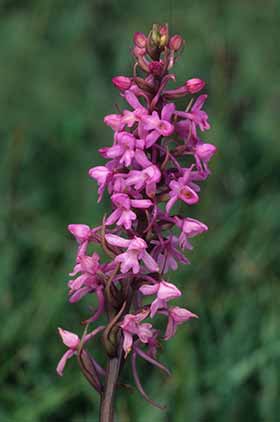Fragrant orchid (Gymnadenia conopsea, sub-species borealis)
When: Mid-June to early July
How many: Small number of colonies with varying numbers of plants

The fragrant orchid, sub-species conopsea, sometimes grows in vast numbers on chalk downland, but is largely restricted to calcareous soils, and does not occur at all in the New Forest. But another fragrant orchid sub-species, borealis, the moorland form tolerant of acid soils, can be found here, albeit in relatively small numbers.
In The New Forest, the fragrant orchid has been described as locally frequent, but to put that in context, Martin Jenkinson in Wild Orchids of Hampshire and the Isle of Wight suggests presence of only ‘a dozen or so generally rather small fragrant orchid populations of 50-100 plants’, and goes on to say that they often escape attention by growing in dense clumps or tussocks of grass and heather, in which the slender, delicate spikes of the orchid are difficult to see.
Relative abundance has, though, seemingly changed in the last 150 years for John Wise, writing in the mid-19th century, called it fragrant-scented orchis and noted: ‘Very plentiful on the south side of the railway, between Burley and Batson’s Clump, about a quarter of a mile above the large ‘Shade pond’. To be found also between Bushy Bratley and Boldrewood.’
In the south of England, however, the New Forest is a stronghold for the moorland form of fragrant orchid, for whilst it is relatively common in the hill pastures of northern and western Britain, in the south it is found only here and at a handful of other sites.
The fragrant orchid is, then, a plant that is unlikely to be noticed during a casual stroll, but one that is definitely worth looking out for, particularly as fragrant orchids can be reasonably readily identified.
They are erect perennials from 15-30 centimetres (6-12 inches) high. Unspotted, narrowly spear-shaped leaves are mainly near the base of the stem. The sweet-scented flowers are pink, lilac, purplish-pink or occasionally white, and occur from the second half of June through to early July in a dense cylindrical spike. In the sub-species found in the New Forest, the lower lip is narrow and lobes are largely absent.
References:
The Wild Flowers of Britain and Northern Europe: Richard Fitter, Alastair Fitter and Marjorie Blamey
Wild Orchids of Hampshire and the Isle of Wight: Martin N. Jenkinson
The Flora of Hampshire: Anne Brewis, Paul Bowman and Francis Rose
The Encyclopedia of British Wild Flowers: John Akeroyd
The New Forest: Its History and Scenery: John R. Wise
More links
Other related links
Search this site

Sadly, 58 animals were killed - 35 ponies, 13 cows, 8 donkeys and 2 sheep, whilst a further 32 were injured - 3 pigs, 9 donkeys, 11 cows and 9 ponies.
(Forty-three accidents occurred in daylight, 15 at twilight and 101 in the dark. Twenty-seven accidents were not reported by the driver involved).
Here's just one horrific example - Three donkeys killed in collision with van at notorious New Forest blackspot (Advertiser and Times)

